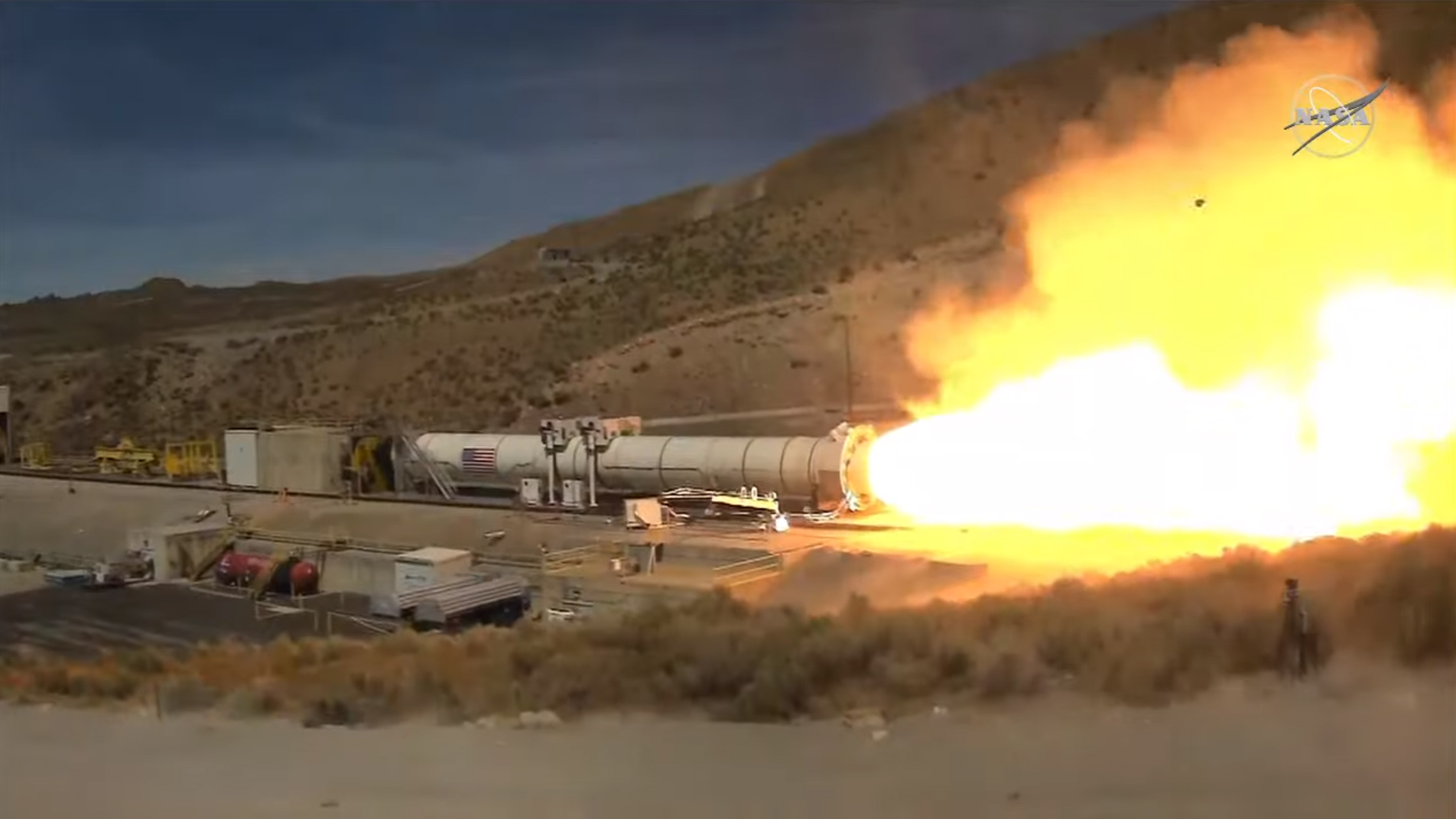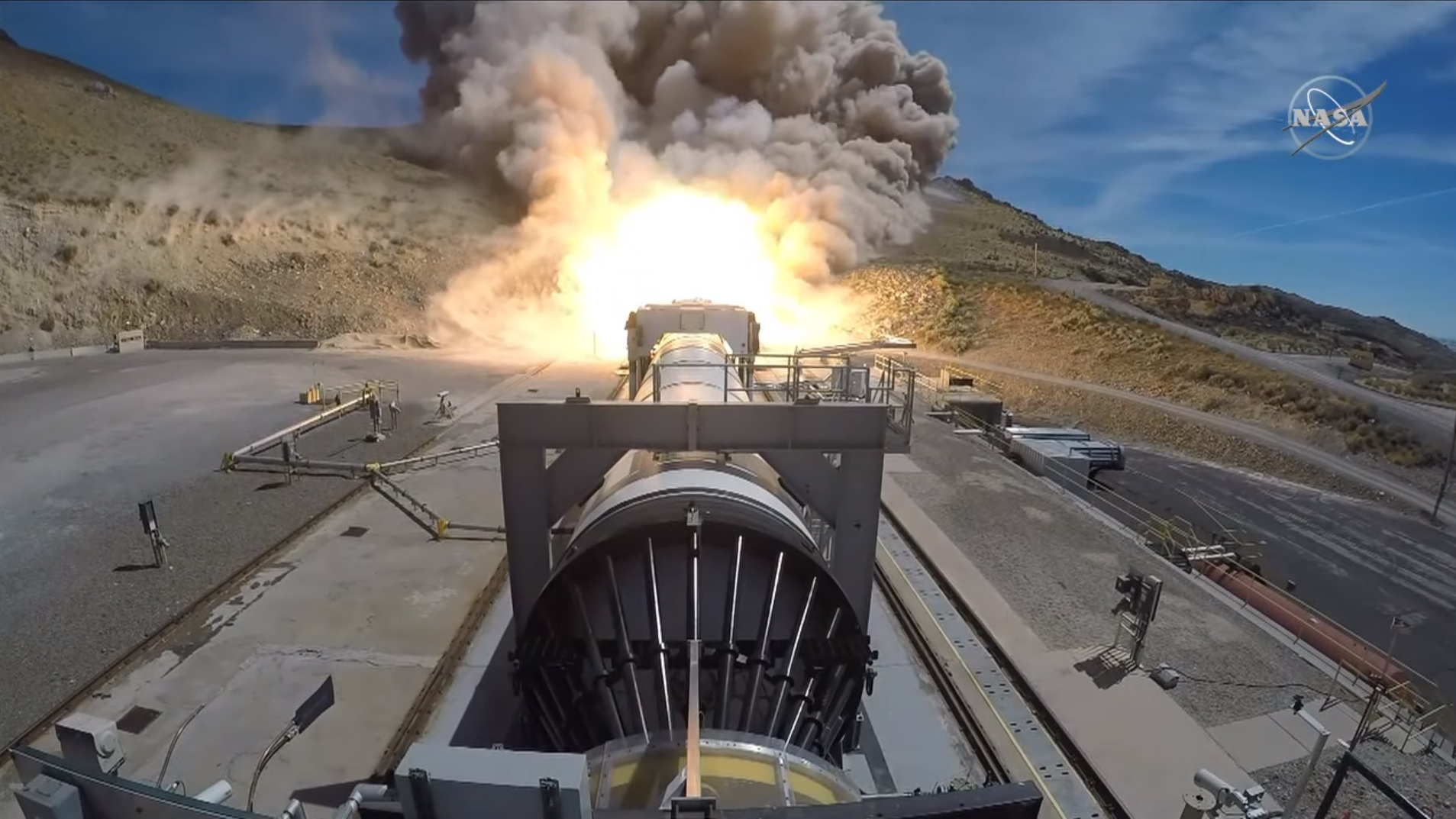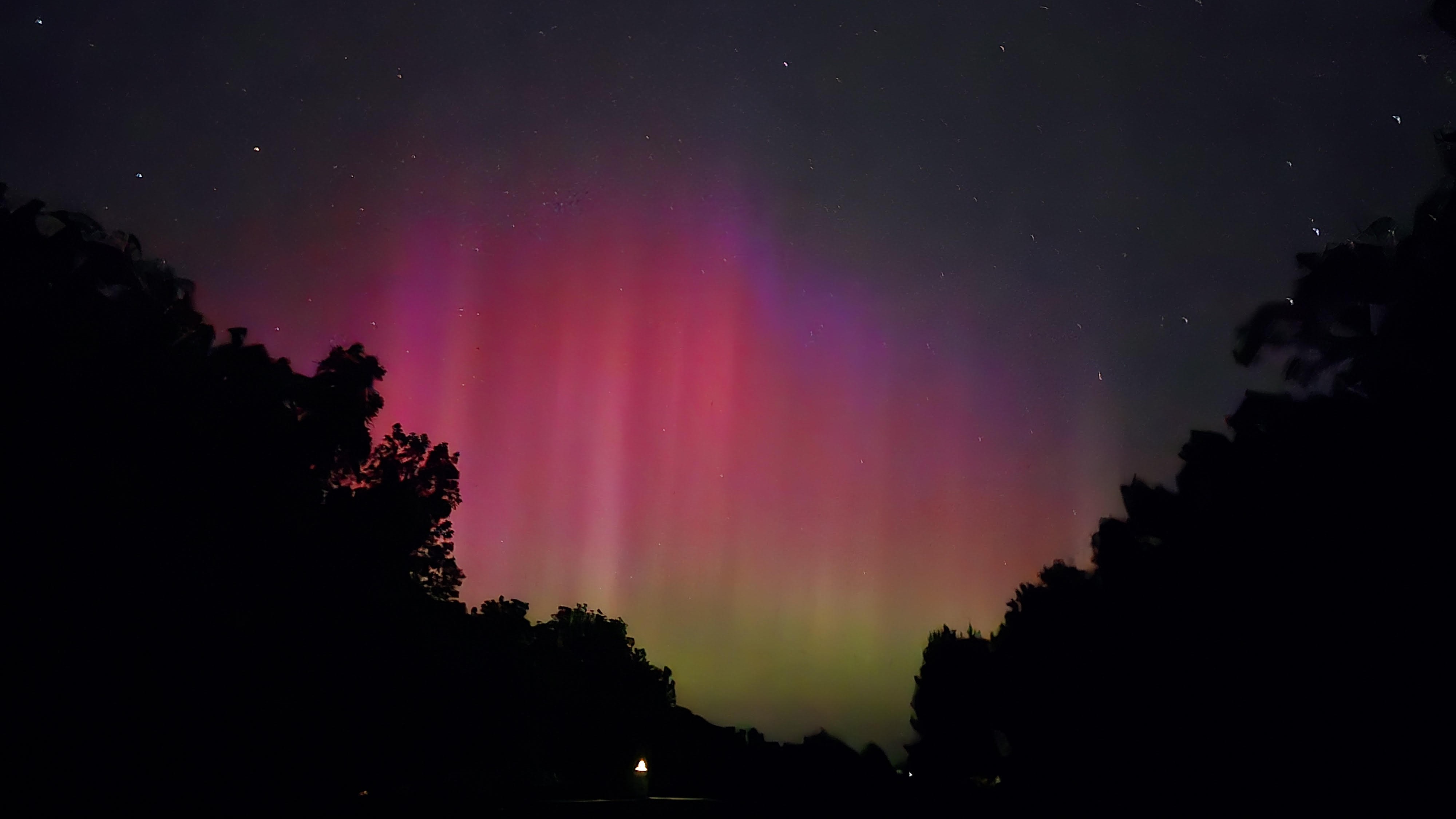NASA test-fires its SLS megarocket booster for future moon missions (video)
NASA's new moon rocket finished a full-scale flight support booster (FSB) test Wednesday (Sept. 2) as the agency gets its Space Launch System (SLS) ready to fly astronauts one day.
The two-minute test was broadcast live from Promontory, Utah at 3:05 p.m. EDT (1:05 p.m. local time or 1905 GMT) on NASA Television, and the results will be analyzed to see how well it went, officials said during the broadcast.
Footage from NASA showed the horizontal booster firing up on its test stand and shooting out orange flames against the gray, hilly landscape. The booster was supposed to fire 3.6 million pounds of thrust upon ignition and remain active for 122 seconds, but the exact performance metrics will be released at a later time. Minutes after the test concluded, steam from the flames' heat continued to rise from the landscape.
Video: Full-size Space Launch System rocket booster test-fired in Utah
Related: NASA's Space Launch System for deep space flights in photos

"The test will evaluate new materials and verify that all the ballistic requirements of the motor are met," said Nikolas Ciaston, a ballistics engineer at SLS booster contractor Northrop Grumman, in a prerecorded video message broadcast on NASA TV just before the booster firing.
Results from this test will also be used to ready the builds of booster rockets after the Artemis 3 mission, NASA said in a statement. Artemis 3 is supposed to be the first human landing on the moon and is scheduled to take place in 2024, but the agency is working on building out its future rockets and spacecraft now to be ready for future missions.
What a view! @NASA astronauts @JonnyKimUSA and @Astro_FarmerBob watched today's SLS Flight Support Booster (FSB-1) test with @northropgrumman's Jeff Foote and Charlie Precourt. pic.twitter.com/4jG3tfBB0uSeptember 2, 2020
"NASA and Northrop Grumman have completed testing for the boosters used for the first three Artemis missions of the agency's lunar program," NASA added in the statement. "FSB-1 builds upon prior tests of the rocket's five-segment solid rocket booster to evaluate improvements and new materials in the boosters for missions beyond Artemis 3."
Get the Space.com Newsletter
Breaking space news, the latest updates on rocket launches, skywatching events and more!
Northrop Grumman, through its predecessor company Orbital ATK, has finished five test firings of the five-segment SLS booster since 2009. Wednesday's test comes about two months after SLS's core fired up for a "green run" test in July, a little later than planned due to the novel coronavirus pandemic slowing things through physical distancing and shipping delays.
Related: Coronavirus pandemic delays key tests of NASA's new SLS megarocket

On Aug. 27, NASA increased the cost estimate for SLS development and said it has notified Congress, as it is mandated to do when costs climb 30% beyond the approved budget. The development baseline cost is now $9.1 billion, human space flight program director Kathy Lueders said in a blog post. The estimated baseline for SLS was $7.02 billion in 2014.
The first flight for SLS is expected in November 2021, which will see the rocket send an uncrewed Orion spacecraft around the moon for a test mission to ready both systems for future flights with humans. After that, a 2023 flight is expected to send a crew of astronauts around the moon, in preparation for a human landing the following year.
Related: NASA has a plan for yearly Artemis moon flights through 2030. The first one could fly in 2021.
Northrop Grumman will make modifications to the SLS booster starting with the Artemis 4 mission, which will be the second flight to land astronauts on the lunar surface. The company won a NASA contract in June to plan production of six additional SLS launches beyond Artemis 3, a contract that NASA said is potentially worth $49.5 million.
Follow Elizabeth Howell on Twitter @howellspace. Follow us on Twitter @Spacedotcom and on Facebook.
Join our Space Forums to keep talking space on the latest missions, night sky and more! And if you have a news tip, correction or comment, let us know at: community@space.com.

Elizabeth Howell (she/her), Ph.D., was a staff writer in the spaceflight channel between 2022 and 2024 specializing in Canadian space news. She was contributing writer for Space.com for 10 years from 2012 to 2024. Elizabeth's reporting includes multiple exclusives with the White House, leading world coverage about a lost-and-found space tomato on the International Space Station, witnessing five human spaceflight launches on two continents, flying parabolic, working inside a spacesuit, and participating in a simulated Mars mission. Her latest book, "Why Am I Taller?" (ECW Press, 2022) is co-written with astronaut Dave Williams.
-
Hughjer The SLS/Artemis program has become a delayed, bloated, and wasteful joke. They have blown their budget again and now costs are over $9 billion? And this factors in that they are building and testing boosters out of leftover Shuttle boosters. And the "new" booster is supposed to be 3.6 million pounds of thrust, while the configuration of the booster on the Shuttle could reach 3.3 million pounds. And considering that the "new" (recycled/hybrid) boosters will be non-recoverable after launch and will just splash down and sink to the bottom of the ocean, this is not a sexy look for NASA at all.Reply
I wouldn't mind seeing them just pull the plug and help subsidize SpaceX with some of that $9+ billion bloat. Chances are, Starship will have already made several laps around the Moon and even Mars before SLS/Artemis gets off the ground.
